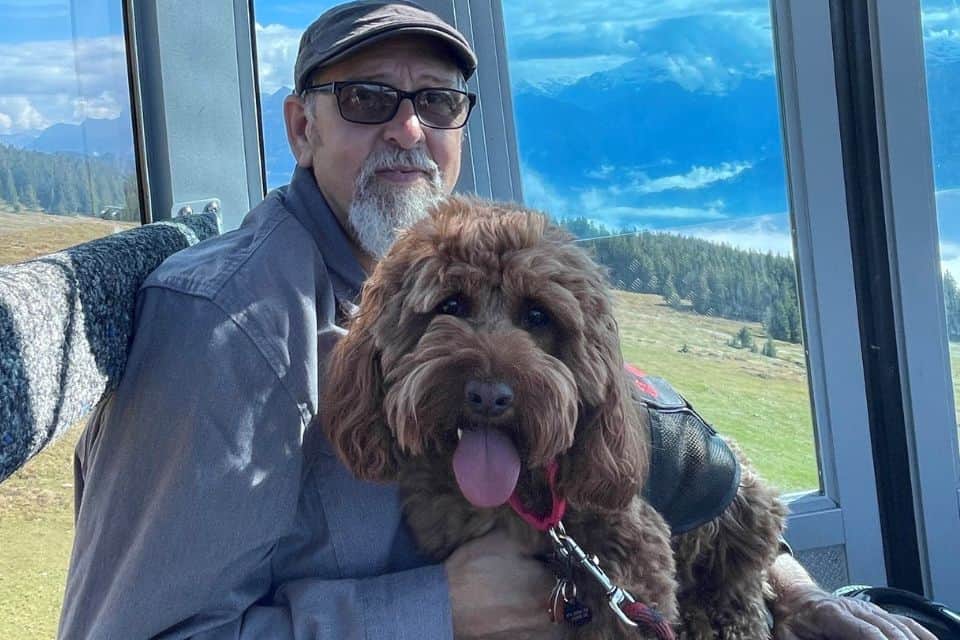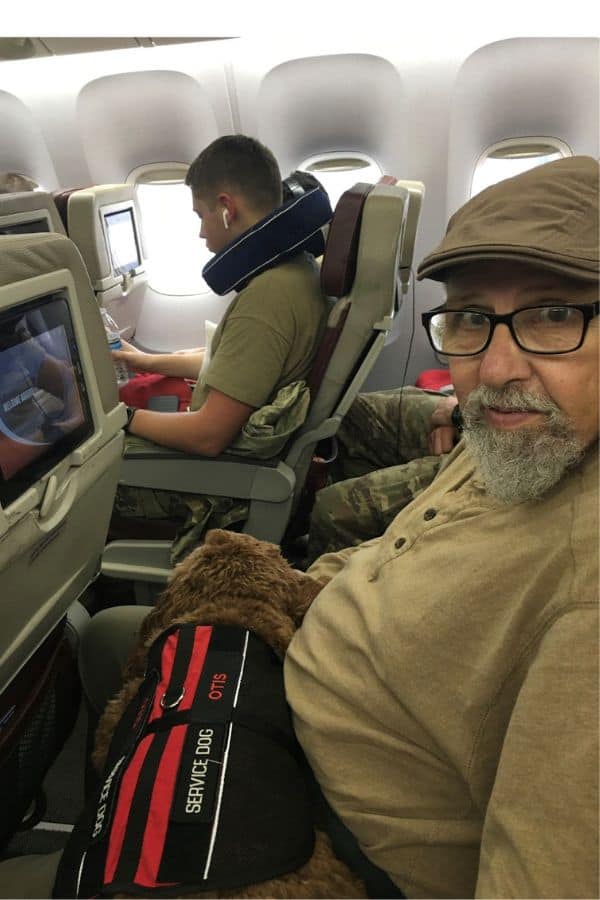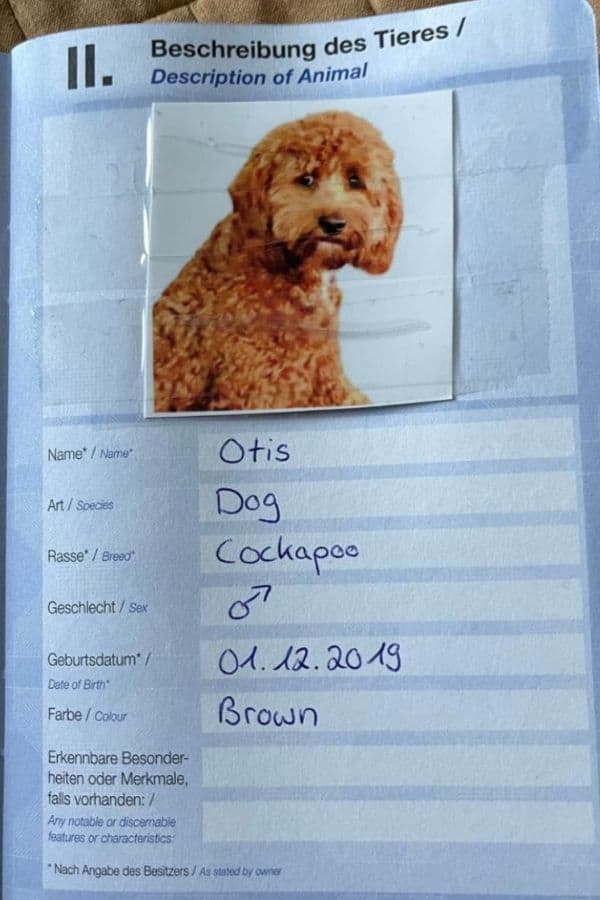
Military space-available (Space-A) travel offers a unique opportunity for eligible veterans to explore the world at minimal cost, and veterans with service dogs can bring them along. Unlike pets and emotional support animals, service dogs are authorized on Space-A flights, but traveling with them requires careful preparation and knowledge of regulations.
In this Q&A, Air Force retiree Tom Redden shares his experience flying Space-A with his service dog, Otis. Learn about Tom’s detailed preparation, the paperwork and gear he brings, and his valuable advice for fellow veterans taking “military hops” with service dogs. Whether you’re a seasoned Space-A traveler or new to the process, Tom’s insights will help you navigate the complexities of flying with a service dog.
Note: Military retirees and veterans with a permanent service-connected disability rated as total (100% DAV) are eligible to fly Space-A. Please see the last section of this article for links to official policies related to Space-A travel and international travel with animals.
First things first. How do you “prove” Otis is a service dog and not an emotional support animal?
There is no official proof. One thing most people don’t realize is that there is no certification or registration for a service dog.
Otis was trained by an organization that trains service dogs for disabled veterans. I was given a letter from the VA stating I would benefit from a service dog. I needed the letter to get him into the training program. He has a certificate stating he completed service dog training, but it’s not a “certification.” Otis also has a card from the training facility stating he is my service dog along with the Americans with Disabilities Act (ADA) information.
The ADA requirement is the dog must perform one task for a disability and be trained in basic obedience training. Otis is trained for several tasks and has three American Kennel Club (AKC) training certificates.
There are only two questions someone can ask a service dog handler for access to public buildings and services:
- Is he or she a service dog for you?
- What task does he or she perform?
I have never been asked those questions on a Space A flight so far. They also can’t ask that the dog perform the task for proof. The terminal must take your word that it is not a fake service dog.
Note from Poppin’ Smoke: Section 10.1 of DoD Instruction 4515.13, “Air Transportation Eligibility” addresses service animals on DoD aircraft.
A service dog is not required to wear a vest, either. I always use a vest, and his leash says “service dog” on it to eliminate any potential questions.
How the dog acts and how it is handled will normally show whether it is real or not. Also, real service dogs aren’t carried by the handler and don’t ride on carts. Those are signs of a fake service dog. There is a difference between a service dog and an emotional support dog.
A dog can be denied access if it is disruptive or goes to the bathroom in inappropriate places, and that rule applies to real service dogs. Also, the service dog must be on a leash at all times.

Is there anything you do differently from other passengers when flying Space-A with your service dog?
I state that I’m traveling with a service dog when I send my request for Space-A.
Also, AMC has a rule about turning in the Statement of Assurance 48 hours in advance, but they have always told me to keep it until we were selected.
Note from Poppin’ Smoke: Section 10.1 of DoD Instruction 4515.13, “Air Transportation Eligibility” has a sample Statement of Assurance.
You need to stay very up-to-date with the paperwork and rules. I have found the person at the AMC counter most likely doesn’t know the requirements. I have had to explain the requirements to them just about every time. You must keep in mind that they don’t see very many service dogs.
How long have you been traveling with Otis?
Otis went through a 12 month training program and has been traveling with me for about 18 months.
What experiences have you had flying Space-A with Otis so far?
We have traveled to Ramstein three times. We flew on the Patriot Express out of BWI and in a C-5 and C 17 out of Dover AFB.
We prefer to fly on the C-5. The C-17 is not comfortable for us, because there’s no guarantee of how much space we will have. Also, it’s much noisier and colder than the other options for Otis. For us with physical disabilities, the C-17 is a challenge for long distance flights as well.
On a C-5 you know the minimum amount of space you could possibly have and it’s easier for me to get Otis comfortable and settled in for a long flight.
(Note from Poppin’ Smoke: learn more about the types of military aircraft here).
Climbing the steps into the C5 was no problem. I allowed him to go in front of me and walk up several steps. Then, I gave him the command to wait until I reached his level. We continued until we arrived at the entrance door.
What paperwork do you need to fly Space-A to Europe with a service dog?
The first step is getting a US Department of Agriculture (USDA) Health Certificate. To get the certificate, the dog needs current shots for the country through which you are entering and the proper microchip. The veterinarian can best advise on the requirements.
For our first trip, we had to go through a veterinarian that was recognized to issue USDA paperwork for entry into the European Union (EU). The problem is, if you are not able to get the paperwork from a military veterinary clinic, you must find a local veterinarian that can do it.
The military veterinarian can issue the paperwork at the time of your visit. A civilian vet must do the exam, fill out the paperwork, and then send it to the appropriate USDA office (in our case it was New York). Then, the USDA overnights the approved paperwork back to you. You may run into problems with non-military vets because the paperwork is time sensitive. It’s only good for about 10 days after the USDA endorses it.
The best option is to get an EU pet passport from an authorized local vet the first time you travel to the EU. We were able to get one in downtown Ramstein. The passport cost around $70 and is good for the life of the dog, as long as the health records are current and updated every 3 years in the EU.

Note that the UK has additional requirements, and the EU passport is not good for the UK.
Also, keep in mind that ADA and other laws related to service dog access only pertain to the United States and its territories. In most other countries, unless you are on a US military installation, they are considered pets. In the EU, they only recognize seeing eye dogs as service dogs.
Note from Poppin’ Smoke: Effective 1 August 2024 the Centers for Disease Control (CDC) have new requirements for bringing a dog back into the United States.
What gear do you bring when flying Space-A with your service dog?
My “Travel Book:”
It has all the documents that I may need, to include current health records, Air Mobility Command (AMC) and commercial airline forms, training paperwork, AMC information about service dogs flying Space-A, and commercial airline requirements.
AMC requires a Statement of Assurance that needs to be signed at the time of selection for the flight. I retyped the form into a word document and updated it as needed. I bring several copies when traveling.
I have two versions of my letter from VA. One has the medical information redacted and one doesn’t.
I also take several copies of the Department of Transportation (DOT) Service Animal Air Transportation form for commercial flights.
Ear Protection: I highly recommend ear protection for the dog. I use the rule of thumb that if I need hearing protection, my dog needs it, too. My recommendation is for Rex Specs hearing protection, which is what military working dogs use. It costs about $80 and they give a military discount.
Muzzle: Some EU countries require that dogs wear a muzzle on public transportation.
Seatbelt Connection: It hooks onto the airplane seat belt, and Otis’ leash attaches to it.
Dog Shoes: In case the surface is too hot for his paws. These dog shoes work well for my needs. They are easy to put on and have two velcro straps to hold them in place. Otis has a winter pair as well.
Pet Blanket: I have used it on the flight when they allow him to lie on the seat next to me.
Service Dog Patches: I had patches that say “service dog” made in the language of the country we are visiting, even though he is not recognized as a service dog.
Food: Enough food for the trip plus portable food and water bowls.
Pet Pads and Pet Diapers: I don’t feed Otis the night prior to a flight and give him minimal water. I must note he has gone 17 hours between potty breaks and has never needed to use the diaper or pads.

What are some differences and considerations when flying Space-A with a service dog compared to flying commercial?
According to the rules for AMC and US commercial airlines, the dog must fit on the floor in front of your seat or, if small enough, on your lap. You would need to research the requirements for individual European airlines.
I have only been on one other Space-A flight with another service dog, and that was on a C-17. So, I’m not sure what they do if the dog can’t fit in front of your seat. A person with a large dog would need to inquire what their options are with AMC. The AMC website’s Pet Travel page has a section for service dog travel.
The commercial air carriers fall under the Air Carrier Access Act ACAA. They require the Department of Transportation (DOT) Service Animal Air Transportation form.
Commercial airports have pet relief stations. Military airports do not. At Ramstein, the process to get on the flight is a long wait before boarding. It’s important to allow the dog to go to the bathroom prior to going through security.
Have you ever had problems finding lodging in Europe that will accommodate your service dog?
Only the first time we went to Ramstein and stayed at the Air Force lodge. They wanted to put us in the building up the road for pets. After a discussion and informing them of the rules for service dogs, we were able to stay at the main lodge. The building for pets was not close to the terminal or facilities, and it would have been difficult for me with my handicap.
We have stayed in hotels and Airbnb’s. We look for pet-friendly lodging. Although Airbnb has a service dog policy it doesn’t apply in Europe, since the EU only recognizes seeing eye service dogs.
Do you and Otis have any more Space-A adventures planned?
Our next trip is out of NS Norfolk in October for 2 weeks in Greece and 2 weeks in Italy. We have never flown out of Norfolk so that will be new to us.
What other tips do you have for fellow veterans who want to fly Space-A with their service dog, especially overseas?
I can’t express how important it is to do your research well in advance. Research each location and know the rules that apply.
For travel to Europe, the EU passport is the best way to go and eliminates the USDA paperwork. With the passport you can fly without a time constraint and in the long run, it’s cheaper.
The military vet is the cheapest and most convenient way to go for the USDA paperwork prior to getting the passport. You need to check with the vet to make sure they can do it. As a rule of thumb, if a military installation has working dogs, they most likely have a vet that could do the USDA paperwork or advise you where to go.
If you have not traveled with your service dog through airport security I would suggest going to the local courthouse when they are not busy and asking if you can train your dog to go through the metal detectors. Otis was trained to sit and stay while I go through the TSA detectors. Then, I call him through.
We always rent a car at Ramstein. I inform the rental car company that I have a service dog. Otis doesn’t shed, so it has never been a problem and I use his blanket on the seat. Also, I vacuum the car before I return it.
I have a leash that can go over my shoulder or attach around my waist so I can go hands-free. I use a cane and need my other hand for my luggage, etc. You can get these leashes on Amazon or any good pet store.
If anyone has questions and I can help, they are welcome to contact me at thomasredden@gmail.com.
* * *
Know the Rules and Regulations
As Tom stated above, doing thorough research before traveling Space-A with your service dog is critical. It is important to know the applicable rules and regulations in the US and any foreign countries you might transit. This advance research will greatly increase your chances of having a smooth trip.
Section 10.1 of DoD Instruction 4515.13, “Air Transportation Eligibility” addresses service animals on DoD aircraft.
As of 1 August 2024 the Centers for Disease Control (CDC) have requirements for bringing a dog back into the United States. The requirements apply to all dogs, including service dogs, and are based on the risk level of the foreign country you visited. Read the details here on the CDC website.
Also, search online for the applicable rules and regulations related to traveling with a service dog to your destination. Remember that each country, plus Hawaii and Guam, has its own laws.
If you’ve never flown Space-A, learn how it works with our Quickstart Guide to Military Space-A Flights.
Before traveling, review AMC’s Passenger Boarding Requirements Brochure. It has photos and descriptions of several types of military aircraft, including the steps Thomas referenced above that he and Otis climbed to board a C-5.
Finally, in addition to the recommended gear for your service dog, make sure you have everything you need for yourself with our Space-A packing list.
Hope to see you out there continuing your adventures!

Definitely go through a base vet (whether service dog or PCS pet travel). Many civilian vets no longer will do this as it’s very time consuming for them and if they don’t do it often, will need to research the latest requirements and requires precise timing.
The ARK at JFK is a 24/7 facility that has all USDA vets that can provide the health certificate, usually within a few hours.
Great tip! Thank you!